In December 1631, the fifth Mughal Emperor, Shah Jahan, commenced the construction of one of the greatest monuments of all time, the Taj Mahal. It is a mausoleum built in the memory of his beloved and favorite wife, Mumtaz Mahal, fulfilling one of the promises that he made to her as she lay on her deathbed: To erect a monument to match her beauty.
Our online virtual tour enables visitors to interactively explore the "UNESCO World Heritage Site", the Taj Mahal at Agra in India. Visitors may tour 22 different areas of the monument and gardens through 360° panoramas, maps, narrated mini-movies, music and text. A preview 360° panorama below a clickable map allows a quick view of any area. Having spotted something of interest, visitors can then click to open a window with a much larger and higher quality 360° panorama, and then zoom in and pan around for a detailed inspection. For example, to view the inlaid semi-precious stones on the Dome itself.

Our online virtual tour enables visitors to interactively explore the "UNESCO World Heritage Site", the Taj Mahal at Agra in India. Visitors may tour 22 different areas of the monument and gardens through 360° panoramas, maps, narrated mini-movies, music and text. A small 360° panorama below a clickable map allows a quick view of any area. Having spotted something of interest, visitors can then click to open a window with a much larger and higher quality 360° panorama, and then zoom in and pan around for a detailed inspection. For example, to view the inlaid semi-precious stones on the Dome itself.

Chawk - I Jilau Khana (Forecourt)

Porticos in the Enclosure

Paradise Garden, near the museum

Al kawther - The Celestial Pool of Ambundance

Paradise Garden - Early Morning

On the Chhaka (Plinth) - by minarates

At the Front of the Chhaka (Plinth)

View From the Rooftop chhatri

On the Roof of the Mausoleum

The Reflecting Pool by Mosque

View from the Minarates

The River Yamuna and the chhaka (Plinth)

On The Chameli Farsh(Terrace)

The Entrance to the Mausoleum

The Rouza (Tombs) in the Mausoleum Crypt

By the jali entrance to the cenotophs

The cenotophs

The interior octagonal Room

Inside the Gatehouse


Virtual Reality (VR) Tour of Taj Mahal
Virtual reality tour of taj mahal.
An immense mausoleum of white marble, built in Agra between 1631 and 1648 by order of the Mughal emperor Shah Jahan in memory of his favourite wife, the Taj Mahal is the jewel of Muslim art in India and one of the universally admired masterpieces of the world’s heritage.
How to explore this VR Tour
- Click on the Audio (speaker button) to listen the background story.
- Click on the “Full screen” button on right upper corner to see the VR tour in full screen mode.
- Each Virtual Tour is connected through various 360 degree Panorama, so with the help of mouse curser you can move the Panorama (on laptop/computer) and with fingers on your mobile phone.
- Various markers are given to explore the VR tours: Click on the plus sign to read about the place, to see the video, photographs and even to attempt the assessment. Click on the black arrow to move forward and backward in a VR tour.
- Click on the black arrow to enter the tour.
Watch the video to know more about this VR tour:

Inside the Taj Mahal, India: 12 Facts + Visiting
By: Author Lillie Marshall
Posted on Published: September 7, 2014 - Last updated: January 6, 2023

Inside the Taj Mahal, is it as beautiful as everyone says?
What are surprises and tips about visiting that we learned during our India teacher tour ? Without further ado, here are 12 things to know about visiting the Taj Mahal: the world’s most famous monument to love, built by emperor Shah Jahan in 1653 in memory of his wife.
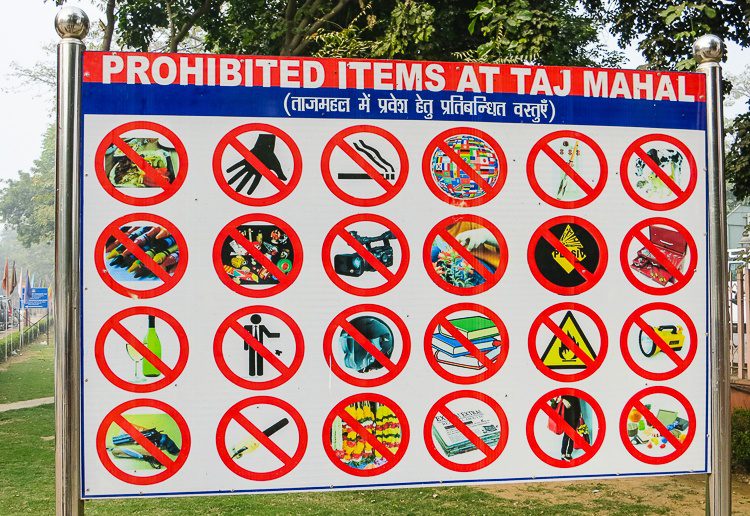
1. Surprising things NOT allowed inside the Taj Mahal:
There are all sorts of items you are not allowed to take inside the Taj Mahal. Study the sign above and see if you agree that some are more bizarre than others. Motorcycle helmets ? Books? Garlands of flowers? What else do you see that surprises you? I can’t even identify some of the prohibited goods!

2. Different lines to get inside for different tickets…
You will have a totally different experience inside the Taj Mahal depending on whether you purchase a “ High Value Ticket ” (as all foreign visitors seem to), or a “General Ticket.”
This begins from the very moment you walk in the door to the main courtyard: High Value Ticket-holders slide into the yard in minutes, while the General Ticket line stretches for blocks.

3. There is one perfect Taj Mahal photo location.
Don’t do what I did in the picture above and take a hundred photos before you reach the best background! The ideal photo spot is centered directly in front of the Taj Mahal, with the blue pools stretching behind you, as in the picture below.

4. How clear people away from a Taj Mahal photo:
In India there is a person working to do every job imaginable, and in the case of the Taj Mahal, there are men who, for a small tip , will clear away all the annoying people in the background of your photo! It’s totally worth it. Without that man’s help, our photos were basically just our heads peeking above a crowd.

5. Beautiful structures are AROUND the main building.
Don’t neglect the stunning side hallways and smaller buildings surrounding the Taj Mahal. They’re gorgeous, too! Look at that astounding corridor pictured above.

6. Your photos may be hazy due to smog (or “mist”).
Like China , India has some serious air pollution. As a result, it’s hard to even see the Taj Mahal in some of my photos! Be prepared for this to be the case for your pictures. It is worth it to edit the photos afterwards to turn up the clarity and turn down all that white.

7. What’s behind the Taj Mahal?
Speaking of “all that white,” I was entranced by the view behind the Taj Mahal: WHITENESS. There’s a river or swamp there, but it was completely shrouded in mist our entire visit. I found it touching that such a famous work of architecture and well-visited monument has a completely wild “back yard.”

8. The line to get inside the Taj Mahal is not actually long.
First, YES, you CAN go inside the Taj Mahal building! Second, see the ridiculous line wrapping around and around the famous building in the photo below? If you have a “High Value Ticket” (as you likely will), you completely skip that line and go right to the center of the Taj Mahal inside the mausoleum itself, just as you skipped the line to get into the main doors to the courtyard.

9. Shoe coverings inside the Taj Mahal…
Upon walking into the mausoleum when you visit the inside of the Taj Mahal building, you will be given little white paper elf boots to protect the historic ground from your footsies. They look great.
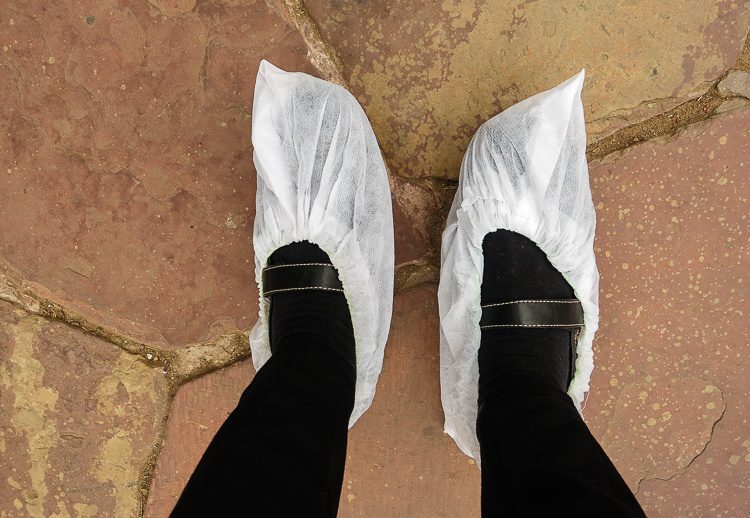
10. Foreigners don’t pay for the bathroom , but Indians do.
This was upsetting. See the sign below.
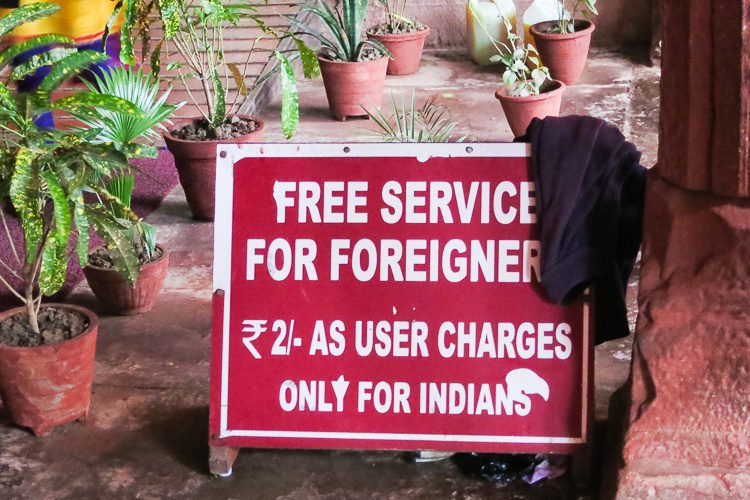
11. Look closely at the walls inside the Taj Mahal.
I’ve always known the Taj Mahal is one of the most beautiful buildings in the world, but I wasn’t prepared for how stunning the tiny details all over it would be. Ogle these unbelievable feats of marble inlay from the Taj Mahal inside walls.
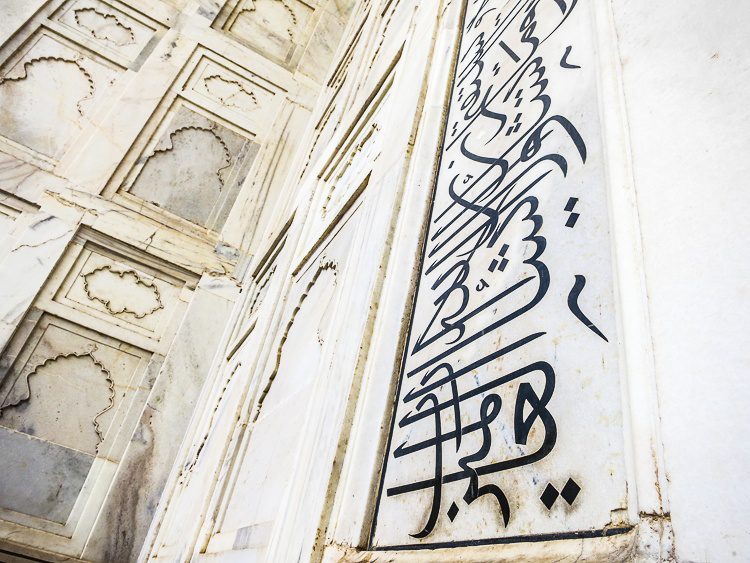
12. The Taj Mahal completely lives up to the hype .
Like the Great Wall of China or the David statue in Italy , there is some trepidation when heading towards a world-famous place. Will it be as great as everyone says? Hands down, the Taj Mahal is awesome, inside and out. It is utterly worth it , so do what you can to go!
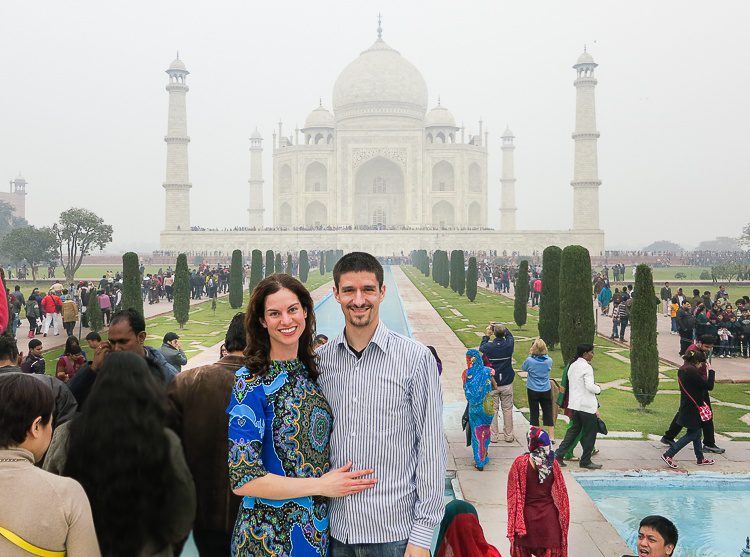
Hotels near the Taj Mahal, Agra:
- Note: These affiliate links below provide a small commission at no extra cost to you.
- Top ratings go to this hotel (click for details and availability)
- Other good options are the Courtyard Agra and Trident Agra (click for pricing)
- Visitors also have positive experiences at the Ramada and the Doubletree
Happy travels, and do feel free to leave comments with your experiences and questions!

The author, Lillie Marshall, is a 6-foot-tall National Board Certified Teacher of English, fitness fan, and mother of two who has been a public school educator since 2003. She launched Around the World “L” Travel and Life Blog in 2009, and over 4.2 million readers have now visited this site. Lillie also runs TeachingTraveling.com and DrawingsOf.com. Subscribe to her monthly newsletter, and follow @WorldLillie on social media!
Check this box to receive email notification of follow-up comments!
This site uses Akismet to reduce spam. Learn how your comment data is processed .
Sunday 17th of October 2021
Hi Lillie, Much more has been written about India, its various cities and uniquely exotic culture and heritage. The way you have put is lucid and engrossing. But I don't find any description regarding Varanasi. Also called as Banaras and Kashi, Varanasi is one of the oldest living cities in the world and considered as the cultural and religious capital of India.
Lillie Marshall
Tuesday 26th of October 2021
Great point! I haven't been to Varanasi but have heard wonderful things.
Roshan Kumar
Tuesday 10th of November 2020
great post. TajMahal is one of the seven wonders of India. You have described the inside view of Tajmahal in such a nice way through amazing pictures. Thanks
Wednesday 11th of November 2020
Thanks for taking the time to read and comment, Roshan!
Wednesday 15th of April 2020
The tickets have more to do with the caste system that determines what a person is allowed. You may have noticed there were places into the Taj Mahal that had wood to walk on whereas other places had the marble. Only the higher castes are allowed to walk on the marble, even with booties. It is the same with the restrooms, and the long lines both into the courtyard and into the Taj Mahal itself. There are four castes that define what your "place" is in society and everything in your life is determined by which caste you are born into from where you can go, what you are allowed to do for employment, and even what kind of vessels you are allowed to drink or eat from. There is another tier of caste and that is the casteless, the untouchables, or the Dalits. These are the very poor of India. The belief system of reincarnation and of "karma" determines your place so you might come back in another life in a better or worse caste based on how "good" you are. The Dalits do not have any rights in India, they have no justice system that protects them and are subjects to the other castes. The system was one way to manage the incredible amounts of people who live in India yet has led to a great deal of racism and abuse. It is an interesting study and well worth learning about.
Thursday 16th of April 2020
Heidi, thank you for taking the time to write this out. Very helpful!
Wednesday 20th of November 2019
It's not a swamp at the back. It's the Yamuna river.
Thank you for that important clarification, Sakhi!
Thursday 6th of June 2019
Agra is just an amazing travel destination, I have been there twice. I would love to go back again and again. I love the Taj a lot.
Thanks for your amazing travel guide and your photos are mind-blowing.
Thursday 13th of June 2019
Thanks, Sarah!
Taj Mahal: A Tour from the Top
A new perspective on an indian icon.
By Google Arts & Culture
The Taj Mahal is one of the great artistic treasures of the world, an instantly-recognisable emblem of India itself. It’s a mausoleum, or tomb, commissioned in 1632 by Emperor Shah Jahan, one of the greatest Mugal Emperors, to house the body of his wife Mumtaz Mahal. Here, you can take in the famous architecture and surroundings in Street View. But what does it look like from up high?
From the top of this minaret, we have a good view across the entire river plain, and of the Taj Mahal itself. The building is perfectly symmetrical, with four minarets, four small pavilions, and one iconic central dome.
Up here, we can see the richly-decorated facade. Before the Taj Mahal, most grand buildings were made of sandstone, but when commissioning this, the emperor Shah Jahan preferred white marble inlaid with semi-precious stones.
Red sandstone can be seen being used to create a remarkable contrast in the smaller - but no less elaborate - building to the west, a mosque, completed in 1643. Inside, the tiled floor has space for precisely 569 worshippers.
A matching building known as the jawab (answer), is found to the east. This was built to provide a perfectly symmetrical view, but may have also been used as a private guesthouse.
Standing on the roof of the mosque, we have a better view of the decoration. The inlaid stone shows no expense was spared in this devoted lover's monument.
To the south are the gardens, laid out in a grid divided by pathways and pools. This style was very popular in the Mughal Empire, and designed to invoke thoughts of the gardens of paradise as described in the Qur'an.
While we're here, why not take a look around the rest of the site and discover the many more treasures of the Taj Mahal .
Hampi - Poetry in Stone
Archaeological survey of india, innovations in architectural astronomy: the jantar mantar observatory, incredible india, mahabalipuram - sculpture by the sea, the golden temple, amritsar, rajghat: varanasi through the millennia, hola mohalla and the traditional attire of the nihang sikhs, rajghat: varanasi through the millenia, nalanda: where civilizations mingled, sarnath - turning the wheel of law, goa: the ultimate getaway.
- Search Please fill out this field.
- Newsletters
- Destinations
- Uttar Pradesh
The Ultimate Guide to the Taj Mahal in India
:max_bytes(150000):strip_icc():format(webp)/10947453_10153084623948270_8191342691038933499_o-591d1e8d3df78cf5fa731909.jpg)
The Taj Mahal looms fairytale-like from the banks of the Yamuna River. It's India’s most recognized monument and is also one of the Seven Wonders of the World. The monument dates back to 1632 and is actually a tomb that contains the body of Mumtaz Mahal—the wife of Mughal emperor Shah Jahan. He had it built as an ode to his love for her. It's made out of marble and took 22 years and 20 000 workers to complete. Words cannot do the Taj Mahal justice, its incredible detail simply has to be seen to be appreciated.
Agra, in the state of Uttar Pradesh, approximately 200 kilometers (125 miles) from Delhi. It's part of India's popular Golden Triangle Tourist Circuit.
The best time is from November to February, otherwise it can be unbearably hot or rainy. You'll be able to get some excellent off-season discounts though.
The Taj Mahal appears to gradually alter its color in the changing light of the day. It’s well worth the effort to get up early and spend sunrise there, as it majestically reveals itself. Visiting around dawn will also enable you to beat the huge crowds that start arriving later in the morning.
Getting There
The Taj Mahal can be visited on a day trip from Delhi. Agra is well connected by rail. The main railway station is Agra Cantt. High speed Shatabdi Express services operate from Delhi, Varanasi, and cities in Rajasthan.
- Find out the best trains from Delhi to Agra .
The Yamuna Expressway opened in August 2012 and has reduced the travel time by road from Delhi to Agra to under three hours. It starts from Noida and a toll of 415 rupees per car for a one way trip (665 rupees round trip) is payable. Read more about hiring a car and driver.
The bus is a good option if getting a train isn't possible. Comfortable, air-conditioned Volvo buses depart from Anand Vihar terminal in New Delhi every hour during the day. The cost is about 700 rupees per person. The buses go via the Yamuna Expressway and stop at Vaango restaurant for a 30 minute snack and restroom break (the toilets are clean).
Alternatively you can fly from major Indian cities, or take a tour from Delhi.
Taj Mahal Tours
Viator (in conjunction with Tripadvisor) offers a popular and highly rated Private Day Tour to Agra and the Taj Mahal from Delhi, as well as a combined Day Tour to Agra and Fatehpur Sikri and Day Tour to Agra with Culture Walk. It's also possible to see the Taj Mahal at night during the full moon on this 2 Day Private Tour of Agra from Delhi.
Alternatively, see the Taj Mahal on one of these recommended Agra day tours: 11 Hour Agra Day Tour including Sunrise and Sunset at Taj Mahal , Private Taj Mahal and Agra Fort Tour including meal with a view and optional professional photographer, or Sunrise or Sunset View of Taj Mahal .
If you're looking for an inexpensive tour option, U.P. Tourism runs daily, full-day sightseeing bus tours (except on Fridays), to the Taj Mahal, Agra Fort and Fatehpur Sikri. The cost is 750 rupees for Indians and 3,600 rupees for foreigners. The price includes transport, monument entry tickets, and guide fees.
Opening Hours
The Taj Mahal opens 30 minutes before sunrise and closes 30 minutes before sunset, usually around 6 a.m. to 7 p.m. every day, except Friday (when it's closed for prayer). The Taj Mahal is also open for night viewing every full moon from 8.30 p.m. until 12.30 a.m., plus two days before and two days after the full moon (a total of five days). Night viewing is suspended during the holy month of Ramadan every year.
Entry Fees and Information
For foreigners, the ticket price is 1,100 rupees and for Indians, the price is 50 rupees. Children younger than 15 years can enter free. Tickets can be purchased at ticket offices near the entry gates or online at this website. (Do note, tickets for the Taj Mahal are no longer able to be purchased at Agra Fort or other monuments, and only offer a minimal discount if you wish to visit other monuments on the same day).
The foreigner's ticket includes shoe covers, bottle of water, tourist map of Agra, and bus or golf cart service to the entry gate. It also enables ticket holders to enter the Taj Mahal ahead of any Indian ticket holders already waiting in line.
Night Viewing tickets cost 750 rupees for foreigners and 510 rupees for Indians, for half an hour’s admittance. Children aged three to 15 years must pay 500 rupees. These tickets must be purchased between 10 a.m. and 6 p.m., one day in advance from the Archaeological Survey of India office on Mall Road. See more details here, including night viewing dates.
Vehicles aren't allowed within 500 meters of the Taj Mahal because of pollution. There are three entry gates—South, East, and West.
- The West gate is the main gate that the majority of local Indian visitors enter through, and it generally has the longest lines throughout the day. However, it's the preferred option at sunrise to avoid the crowds at the East gate.
- The East gate is popularly used by foreign tourists, as it's closest to a number of well-known hotels. It usually has shorter queues except for at sunrise, when large groups tend to arrive there. If you buy your ticket in advance the day before, it's still the best entry point. Do note that the ticket office (in Shilpgram) is inconveniently located about 10 minutes walk from the gate. Buses, golf carts and cycle rickshaws are available for those that can't, or don't want to, walk.
- The South gate is the least-used gate. It's close to a congested market area where many of the cheap hotels are situated, making it favored by budget and independent travelers. However, it doesn't open until 8 a.m. A huge sandstone gateway provides access to the inner compound there.
There are exclusive ticket counters for foreigners at both the East and West gates.
Security at the Taj Mahal
Strict security is in place at the Taj Mahal, and there are checkpoints at the entrances. Your bag will be scanned and searched. Large bags and day packs aren't allowed to be taken inside. Only small bags containing essential items are permitted. This includes one cell phone, a camera, and a water bottle per person. You can't bring edibles, tobacco products or lighters, electrical items (including phone chargers, headphones, iPads, torches), knives, or camera tripods inside. Cell phones are also banned during night viewing sessions, although cameras are still allowed. Luggage storage facilities are provided at the entry gates.
Guides and Audio Guides
If you want to marvel over the Taj Mahal without the distraction of having a tour guide with you, government-approved AudioCompass provides an inexpensive official Taj Mahal audio guide on its cell phone app. It's available in many foreign and Indian languages, including English, French, German, Italian, Spanish, and Japanese.
See the Taj Mahal Without Going Inside
If you don’t want to pay the costly admission fee or battle the crowds, you can get a great view of the Taj from across the river bank. This is ideal for sunset. One such place there is Mehtab Bagh—a 25 acre Mughal garden complex directly opposite the monument. The entry cost is 250 rupees for foreigners and 20 rupees for Indians, and it's open until sunset. Unfortunately, an unsightly barbed wire fence has been erected beside the river to stop tourists from wandering along it.
It's possible to take a row boat out on the river. Head down the path along the eastern wall of the Taj Mahal to the riverside temple, where you will find boatmen.
There's also a little-known abandoned watchtower across a sandy field on the eastern side of the Taj Mahal. It's an ideal place for a splendid sunset view of the monument. Reach it by heading east from the East Gate and taking a right at the fork in the road. Pay the official 50 rupees to enter.
Uttar Pradesh Tourism's Taj Khema hotel offers notable vistas of the Taj Mahal from its gardens too. A new marble bench was installed on a mound there in early 2015, especially for visitors. Sip tea and watch the sunset! The hotel is located about 200 meters from the monument, on the eastern side. It's a government-run establish, so don't expect great service though.
Another option is the rooftop of the Saniya Palace hotel, on the southern side of the Taj Mahal.
Cleaning of the Taj Mahal's Exterior
The first thorough cleaning of the Taj Mahal to remove the yellow discoloration from pollution and restore the marble to its original brilliant white color occurred in 2018. To achieve this, a natural clay paste was applied to the monument's exterior. The clay packing of the main dome remains and is planned to be undertaken in stages, starting from the front of the monument.
Taj Mahotsav takes place at Shilpgram in Agra, right near the Taj Mahal, from February 18-27 each year. The focus of this festival is on arts, crafts, Indian culture, and recreating the Mughal Era. It gets underway with a spectacular procession that includes elephants, camels, and drummers. Camel rides are on offer, and there are also games for the kids and a food festival. The venue has special significance, as it's apparently located on the site where the artisans who built the Taj Mahal once lived.
Where to Stay
Unfortunately, many of the hotels in Agra are as uninspiring as the city itself. However, these top Agra hotels should help make your stay a memorable one. There are accommodations to suit all budgets and many have Taj views.
Dangers and Annoyances
Visiting the Taj Mahal can be overwhelming for all the wrong reasons. Be prepared to encounter plenty of beggars and touts there. According to this news report , it has become an increasingly troublesome problem, and many visitors go back home feeling cheated, threatened and abused. Touts operate in sophisticated gangs that have counterparts in other cities who identify potential targets at railway stations. Once the tourists reach Agra, the touts start pestering them by claiming that they are guides or taxi drivers. They commonly use ploys such as free taxi rides or the promise of heavy discounts.
Note: There are 24 hour official prepaid auto rickshaw and taxi booths just outside Agra railway station. Use these to avoid the hassle, and if you book a tour there check the quality of your vehicle to make sure it's satisfactory.
Do be sure to tell auto rickshaw drivers which Taj Mahal entry gate you wish to be taken to, otherwise it's likely that you'll find yourself dropped off in the area where expensive horse and cart or camel rides wait to take tour groups to the west gate.
Apparently, there are only 50-60 approved guides at the Taj Mahal. However, more than 3,000 touts posing as photographers, guides or middleman, openly solicit customers at the monument's three gates (especially at the western gate, which receives around 60-70% of visitors). Hundreds of hawkers (who pay bribes to the police) are also a problem at the Taj Mahal, despite being officially banned.
In addition, foreigners, particularly women and parents with young children, are frequently asked to pose for photographs (or even being photographed without permission) by other people including groups of guys. This can be intrusive and uncomfortable. This news article warns about selfie seekers at the Taj Mahal.
Lastly, do be aware of the notorious gem scam , which is alarming prevalent in Agra.
Other Attractions Around Agra
Agra is a rather dirty and characterless city, so don’t spend too much time there. In case you're wondering what else to do in and around the city, take a look at these Top Places to Visit in Agra and Around.
Nature lovers will appreciate a trip to the Bharatpur Bird Sanctuary at Keoladeo Ghana National Park, 55 kilometers (34 miles) from Agra.
Related Articles
More related articles.

Visiting the Taj Mahal: Everything you need to know
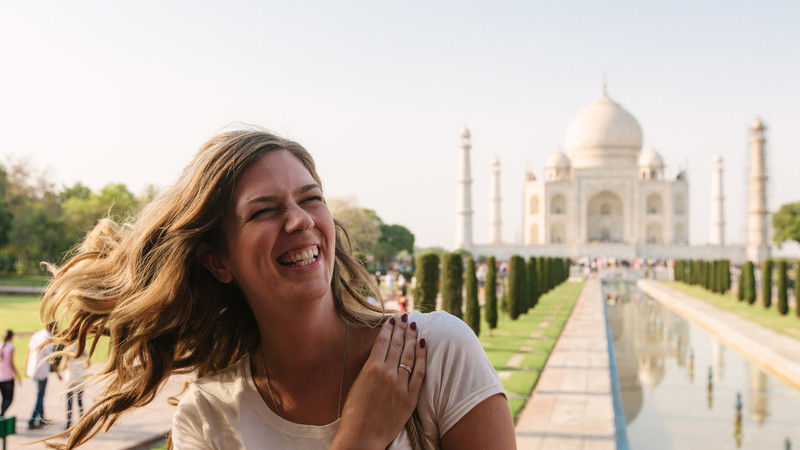
Is there a sight more iconic, more beautiful, more jaw-droppingly spectacular than the Taj Mahal?
Quite honestly, we can’t think of one.
At the very least, there’s no mausoleum more grand, no declaration of love more apparent than building a marble masterpiece for one’s favorite wife… And no better reason to travel than seeing its magnificence up close.
After all, this is art. Built in Agra, India between 1631 and 1648, it’s also history. And, of course, it’s the perfect opportunity to take some otherworldly photos. So, to help visitors prepare for their Taj Mahal travels, we’ve prepared a little guide, enlisting the help of some Intrepid experts – from Destination Managers to acclaimed trip leaders – to cover all the bases.
Coming up: what to bring, where to take the best snaps, what else to see in Agra (and beyond), and so much more…
Before you arrive at the Taj Mahal
That old saying ‘patience is a virtue’ really comes into its own when discussing the Taj Mahal.
Be prepared to be surrounded by hundreds (if not thousands) of people. These include Indian men, women and children who may ask to take photos with you.
To prepare with the help of other travelers and a local tour guide, consider taking a group tour. Intrepid have Taj-visiting trips that range from 8-day Golden Triangle tours (now with solo-only departures !) to 15-day trips dedicated to food , to 19-day trips combining the highlights of India and Nepal .
If you’re more pressed for time, you can check out the Taj Mahal on a whirlwind day tour from Delhi. Check out Urban Adventures to see the itinerary that we’d recommend for this. And while you’re at it, check out their day trips in Delhi , Jaipur , Varanasi and Mumbai !
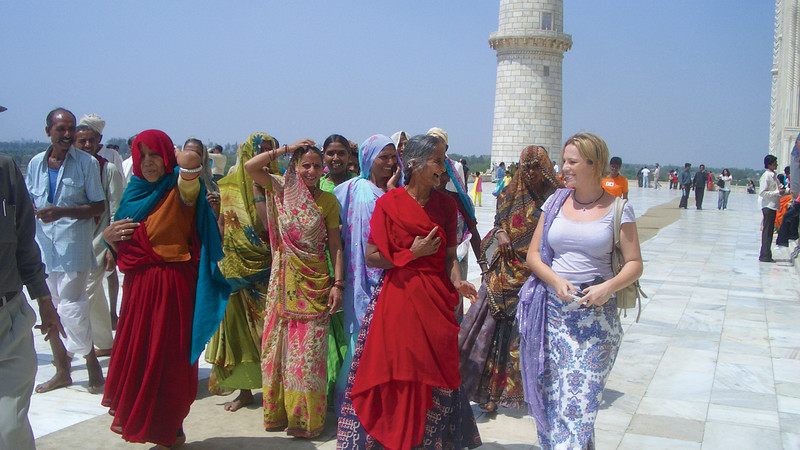
What to bring to the Taj Mahal
Always leave your valuables in the hotel. There are lockers available at the Taj but it’s best to have minimal belongings on you so you don’t spend too much time checking in.
You really only need to bring the following in one small bag:
What to wear to the Taj Mahal
There is no dress code but you should still be respectful. If you want to enter the mosque, you will need to cover your head, shoulders and knees.
It gets hot in Agra and there is very little shade, so wear light clothing and make sure you wear sunscreen. Then again, Agra also gets very cold in winter (Nov-Feb) so layers are your friend too.
If you visit with Intrepid, you’ll be taken there earlier in the day or later in the afternoon to avoid the worst of the heat.
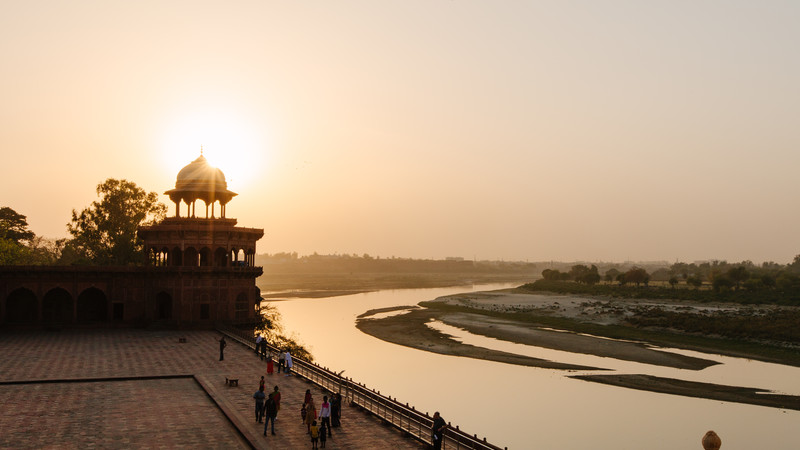
Having been to the Taj a few times, I’ve learnt the importance of wearing shoes that are easy to remove. You need to take your shoes off when you go inside and the easier they are to slip on and off the better. This actually applies to much of India – shoes with loads of laces are hard!
Other things you need to know
No food is allowed inside.
Cigarettes and lighters are also not allowed.
Tripods and additional lighting equipment need prior permission to be brought with. Photography inside the mausoleum is prohibited. Most electronics (except cameras and small video cameras) are not allowed.
Be wary of touts, thieves and rude shop keepers. It’s a busy, high-pressure area, but keep your wits about you and you won’t need to worry!
When you’re at the Taj Mahal
Go early, wait for space to explore and photograph, and get yourself away from the crowds (if possible).
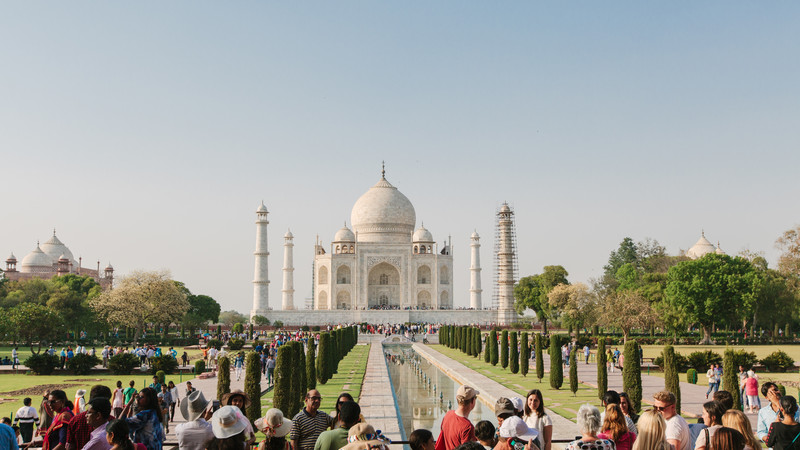
And simply focus on taking in all the magic. Even Intrepid leaders who see the Taj Mahal monthly (or more!) remain in awe of it. Sana Jinah , one of the company’s inspiring female tour guides, has some tips on how to do this:
The Taj Mahal is a place for exploring quietly on your own or with loved ones. So, once I’m done briefing my groups I give them a good 2-3 hours inside the Taj. There are ways I try to make the experience special and memorable for travelers, but if I say what they are then they will no longer be surprises! The Taj has such a charm. Every time I see it it looks different (due to the direction of the sunlight). It’s so beautiful…
She also recommends those looking for optimum conditions try visiting the Taj Mahal at sunrise on a clear day.
Tips for taking photos at the Taj Mahal
Everyone wants that iconic shot of themselves at the Taj Mahal. You know the one – where you sit on the bench and the grandeur of the marble mausoleum forms the backdrop.
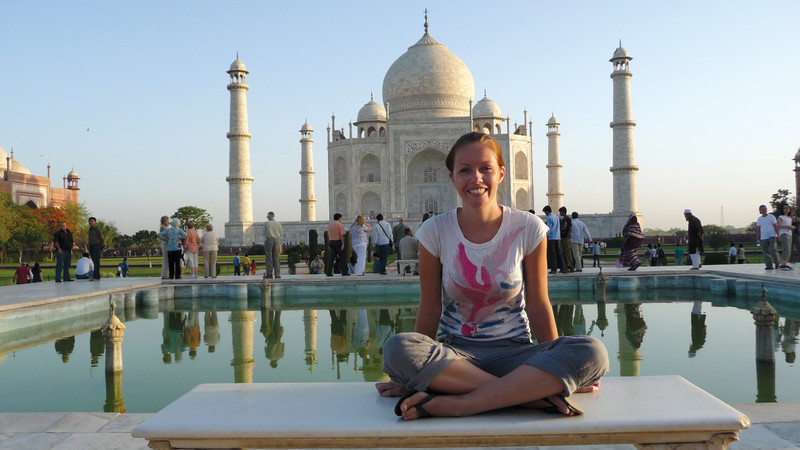
Below are some photography suggestions from Intrepid’s General Manager in India, Pravin Tamang . (His photography is amazing – check it out !)
- Shot from the arch of the main doorway
- Capture the reflection of the fountains that line the route towards the Taj Mahal’s main platform
- Shot of Taj Mahal from the riverside with the reflection on the river
- Shot from the other side of the river, ‘Mehtab Bagh’, where you get a glimpse of Taj
- The Taj Mahal can also be shot from some parts of the Red Fort
You can also get great photos from the many rooftops of restaurants close to the Taj Mahal. Unfortunately, Agra does get pretty smoggy, so winter can often have poor visibility earlier in the day and around sunset. That said, this can make shots look very atmospheric!
What to do after visiting the Taj Mahal
First, go back to your hotel room, take a shower, and revel in the relative peace and quiet. Then explore these cool destinations both in and out of Agra:
What to do in Agra
The Taj Mahal is, quite clearly, the star of the show in this northern Indian city. But the Agra Fort is also stunning, especially if you didn’t get a chance to go to the Red Fort in Delhi. A 16th-century Mughal monument and UNESCO World Heritage site, it’s a sight not to be missed.
Despite being located on the Golden Triangle tourist circuit, there’s less to do in Agra than in many other Indian cities. It’s pretty polluted from the heavy industry (more on that later) and you likely won’t spend too long there, whatever the trip.
One way that Intrepid tries to show visitors a different perspective on the country is by (sometimes) taking travelers to Sheroes Hangout . Just blocks from the Taj Mahal, it’s a small cafe run entirely by female acid attack survivors. Here, victims of attacks are employed and tell their stories. It can be confronting, but also inspiring and memorable in equal measures.
SUBSCRIBE TO INTREPID’S NEWSLETTER FOR MORE TRAVEL GUIDES, COMPETITIONS, GIVEAWAYS & MORE
Where to go outside of Agra
There are various great destinations only a few hours drive (well, 4-7) from the Taj Mahal. Of these, Orchha, Jaipur and Pushkar are all tourist-friendly, peaceful and beautiful places.
Orchha is a town that travelers often overlook. This is a shame, because it’s historic, laid-back and has a bunch of beautiful temples. It’s not always on tour itineraries, but you CAN visit it on this 15-day trip from Delhi to Kathmandu (cooking demo and palace visit included!).
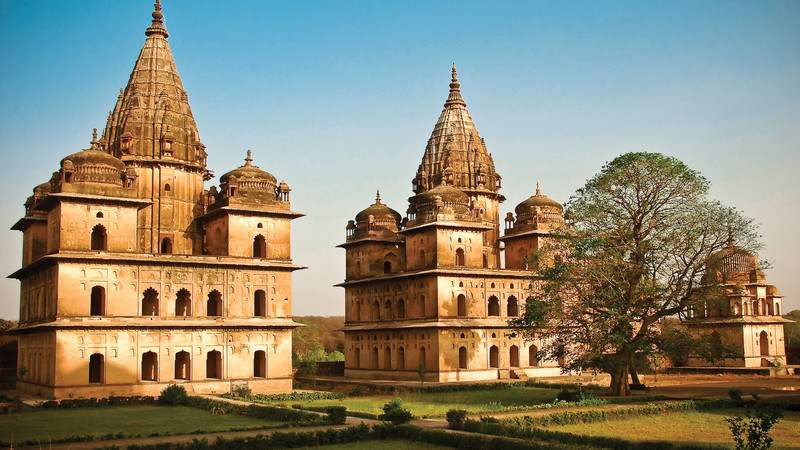
Chaturbhuj Temple in Orchha
Jaipur is much more well-known. Also known as the ‘Pink City’ , the capital of Rajasthan is full of chaos, charm and unique architecture. Visit the hilltop Amber Fort, haggle in the enchanting bazaars, and consider taking a hot air balloon over the city to take it all in.
Pushkar is another underrated town. One of the oldest and most serene towns in India, it’s home to Pushkar Lake, a sacred spot for Hindus that’s utterly dazzling at sundown. Because of its holy nature, the vegetarian food here is simply unmissable. Visit on this 15-day trip all around Rajasthan.
A final note about the Taj Mahal’s mud therapy
As you may have read or heard, the Taj Mahal has recently been undergoing a very thorough clean. Yep, to be precise, a mud mask as of April 2018.
Why? Air pollution from factories in Agra had been slowly turning the Taj Mahal’s ivory-white surfaces yellow – and this was one way of restoring them to their former glory. The work – applying a clay traditionally used to clean marble to the entire structure of the Taj – was carried out by the Archaeological Survey of India. And this work was part of a series of restorative projects carried out on the historic site.
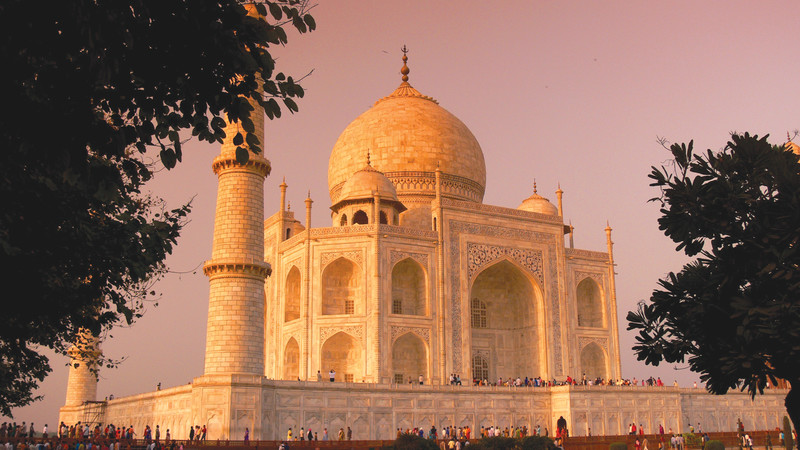
(Image credits from top to bottom: Intrepid Travel, Stephanie Young, Intrepid Travel, Intrepid Travel, Sarah Dibdin, Chris Grundy, Hamish Cattell, David Williams)
Feeling inspired?
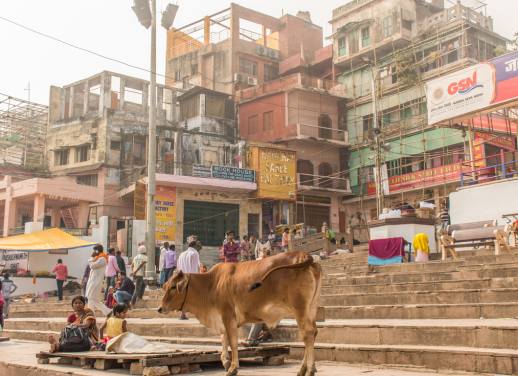
Bex Shapiro
Born in London and based in Toronto, Bex is happiest anywhere she can connect with interesting people over good food. She's passionate about sustainable travel and powerful storytelling, and her favourite cities are New York and Shanghai. She's also the Senior Editorial Manager at Intrepid. Follow her adventures on Twitter and Insta @BexShapiro.
You might also like
10 must-see places when you visit georgia, the truth about antarctica – 8 burning myths..., why you should hike in the winter, learn how to leave hack your 2025 canadian..., level up your australian public holidays in 2025, how to make the most of us federal..., make the most of nz’s public holidays in..., top us national parks, how to maximise your annual leave using uk..., 7 incredible hikes in denali national park, unique getaways for your next girls’ trip.
Is the Taj Mahal a Mosque? Everything You Need to Know to Visit the Taj Mahal in 2024
If you’ve ever wondered whether the Taj Mahal is a mosque, you’re not alone. Many visitors are curious about the religious significance of this architectural wonder of the world. The Taj Mahal, located in Agra, India, is a UNESCO World Heritage site that attracts millions of visitors from all over the globe.
So, is the Taj Mahal a mosque? The answer is no. Although the Taj Mahal complex includes a mosque and other buildings, it is primarily a mausoleum. The central structure houses the tombs of Shah Jahan and his wife Mumtaz Mahal.
We’ll cover how to visit the Taj Mahal, from getting tickets ahead of time, to when to visit and what to bring with you. We’ll also cover where to stay, and the best tour to take if you want to visit from Delhi.
We visited the Taj Mahal as part of our Family Gap Year ( what is a Family Gap Year? ) when our kids were 5 and 8. We spent more than a month in Northern India exploring from Delhi to Jaisalmer, and up to Dharamshala.
The Taj Mahal was the 6th of the “New Wonders of the World” that our family has visited. You can see the Colosseum in Rome via a golf cart tour , or climb to Machu Picchu after exploring the Sacred Vally of Peru . From Christ the Redeemer in Brazil , to Chichen Itza in Mexico , we’re hoping to see all seven as a family!
This article may contain affiliate links, which means we may earn a small commission if a reader clicks through and makes a purchase. As an Amazon Associate, we earn from qualifying purchases at no additional cost to you. All our recommendations are our own and are in no way influenced by any advertiser or commercial initiative.
At the bottom of this post, d ownload a free guide: 6 Safety Tips for Traveling with Kids: What You Should Know Before You Travel .
Taj Mahal Sunrise Tour from Delhi From Delhi – Includes Taj Mahal, Agra Fort, Mehtab Bagh, and buffet breakfast at 5-star Hotel
Taj Mahal Sunrise Tour from Agra From Agra – Includes Taj Mahal, Agra Fort, Fatehpur Sikri, and Agra with buffet lunch
Table of Contents
Is the Taj Mahal a Mosque? What is the Taj Mahal?
The Taj Mahal is a mausoleum, built on the south bank of the Yamuna River, in the city of Agra by the Mughal emperor, Shah Jahan, to house the tomb of his favorite wife, Mumtaz Mahal. Commissioned in 1632CE, the immense structure is constructed of white marble and took seventeen years to complete.
The tomb is the centerpiece of a 17-hectare (42-acre) complex, which includes a mosque and a guest house, and is set in formal gardens bounded on three sides by a crenelated wall. The mosque on the west side, the guest house on the east, the main gateway on the south, the outer courtyard, and its cloisters were added subsequently and completed in 1653 CE.
The site in its entirety cost an estimated 32 million rupees at the time of completion, which in 2015 was approximately ₹52.8 billion rupees or $827 million dollars. The construction project employed some 20,000 artisans under the guidance of a board of architects led by the court architect to the emperor, Ustad Ahmad Lahauri.
Lodging: Booking.com Flight Deals: Skyscanner Rental Cars: Discover Cars Airport Transfers: Welcome Pickups
Digital SIM Cards: Airalo eSIM Travel Insurance: SafetyWing
Why is the Taj Mahal Famous?
Regarded by many as the best example of Mughal architecture and a symbol of India’s rich history, the Taj Mahal was designated as a UNESCO World Heritage Site in 1983. The Taj Mahal attracts some 7–8 million visitors each year and is considered “the jewel of Muslim art in India and one of the universally admired masterpieces of the world’s heritage”. In 2007, it was declared one of the “New 7 Wonders of the World” along with other monuments such as the ancient city of Petra and the pyramid of Chichen Itza.
A Symbol of Eternal Love
The Taj Mahal is also a symbol of eternal love, considered one of the most enchanting and beautiful places in India. Commissioned by Emporer Shah Jahan in honor of his favorite wife Mumtaz Mahal, whose name means something like “Chosen One of the Palace”, who died while giving birth to their 14th child.

How Can I Visit the Taj Mahal?
There are several ways to visit the Taj Mahal. If you are looking to view the Taj Mahal with the least amount of people, the best way is to stay in Agra and get up early to be at the gates before the site opens. You can visit on your own, or take a sunrise tour .
You can also take a tour of the Taj Mahal from Delhi . These include transportation to and from your hotel in Delhi, tours of both the Taj Mahal and Agra Fort with a private guide, and a buffet breakfast at a 5-star Hotel.
Taj Mahal Sunrise Tour from Delhi
This tour starts early- expect a 3 am or earlier pick-up from your hotel in Delhi. You’ll have a 3-hour drive to Agra, where you will head directly to the Taj Mahal. After spending time at the site, you’ll head to Agra Fort, then on to Mehtab Bagh where you can view the Taj Mahal from across the river.
This tour gets five-star reviews and includes a hearty buffet breakfast before you head back to Delhi.
Book Now: Taj Mahal Sunrise Tour from Delhi
Taj mahal sunrise tour from agra.
This highly-rated tour is a private full-day tour beginning and ending in Agra. You’ll start with the Taj Mahal, head back for a rest and breakfast at your hotel, then continue your day with a visit to the Agra Fort in the afternoon. After an included lunch, you’ll drive out to the ghost town of Fatehpur Sikri, your third UNESCO World Heritage Site of the day.
“He always seemed to find beautiful and quiet spots to walk us through the history of each of the monuments we visited during the day, despite the nearly overwhelming weekend crowds. Speaking of crowds Rishi knew all of the routes through each monument ensuring the least traffic and with him long queues seemed to just disappear.” – Eli (read more reviews )
Book Now: Taj Mahal Sunrise Tour from Agra
Getting to the Taj Mahal
The Taj Mahal is located in the town of Agra, Uttar Pradesh, India, which is about an hour and 40 minutes by fast train, or around 3 hours by car from Delhi. You can visit on a day trip from Delhi, or spend a day or two in Agra visiting other nearby sites such as Agra Fort.
Where to Stay in Delhi
We highly recommend staying in New Delhi. The streets of Old Dehli are quite narrow and crowded, and you’ll be negotiating walking in areas with high traffic and few sidewalks. We enjoyed walking around Connaught Place and recommend staying close by. This area is also at a metro stop, which we found was great for getting around to other attractions in Delhi, like the Akshardham, without having to worry about the traffic.
Recommended Delhi Hotel: Hotel Palace Heights
This hotel has a fantastic location right on Connaught Place. The rooms are comfortable and the onsite restaurant gets good reviews as well. You’ll be an easy walk to restaurants and shopping and a quick metro or tuk-tuk ride to wherever you’d like to go around the city.
Book Now: Hotel Palace Heights
Where to Stay in Agra, India
Best Budget Hotel: Joey’s Hostel Agra
We stayed at Joey’s Hostel Agra , where you can sit on the rooftop terrace and order dinner and look out over the Taj Mahal. This was also a great place in that it is less than a five-minute walk to the east gate and when you are getting up before dawn, makes getting there easy.
We had a private family room with a full bed and bunk beds for the kids and our own private bathroom. We had breakfast included (though it was not great), which was not served upstairs, but on the rooftop next door. Everyone was very friendly and helpful.
Book Now: Joey’s Hostel Agra
Best Mid-Range Hotel: The Coral House Homestay by the Taj
This colorful homestay includes shared areas full of plants and free use of bicycles to explore the area. Breakfast is included and guests rave about how comfy and well-cared for the space is. Includes a roof terrace with views of the Taj Mahal. About a 10-15 minute walk from the Taj Mahal.
“‘A great experience right next to the Taj Mahal. I wish I stayed there longer. My most comfortable night in India so far.” – MIchele (read more reviews )
Book Now: The Coral House Homestay by the Taj
Getting Tickets to the Taj Mahal
The best way to purchase tickets is online, up to a week ahead of time. There is a slight discount to do so, and this is a great way to ensure you are able to get a ticket and do not have to wait in line to buy them. Buy Taj Mahal tickets online .
Tickets are also available for purchase one hour before sunrise and until 45 minutes before sunset at either the East or West Gate. You can enter via the West Gate, near Saheli Burj, and at the East Gate. You cannot enter through the South Gate but you can exit there.
After the Taj Mahal closed in 2020, it reopened six months later, then closed again, before reopening in 2021. When it first reopened, tickets were only sold online, and not available in person. In-person ticketing has resumed, so if you don’t get tickets ahead of time, you should be fine, you’ll just need extra time to wait in line.
The price of admission for Foreign Tourists is around $13 USD, plus an additional fee (about $3 USD) to enter the mausoleum (highly recommended). Children under 15 years old are free.
Can I Visit the Taj Mahal at night?
Yes, there are special night viewings of the Taj Mahal on the full moon, and on the two days before and after the full moon. Time slots for your night tour begin at 8:30, with the final slot at 30 minutes after midnight. Only 50 tickets are available for each time slot. There are no night viewings on Fridays, or during Ramadan. For a full schedule and to book night tickets, check out the government website .
When is the Taj Mahal Open?
You can visit the Taj Mahal every day except Friday, and it opens 30 minutes before sunrise and closes 30 minutes before sunset on normal operating days. You can enter via the West Gate, near Saheli Burj, and at the East Gate. You cannot enter through the South Gate but you can exit from there.
When is the Best Time of Year to Visit the Taj Mahal?
You can visit the Taj Mahal year-round, but the dry, cooler months of October to March are ideal. Even though you are most likely visiting in the early morning, it can still get quite hot in the summer months.
Entering the Taj Mahal
There can be long lines just before dawn as the Taj Mahal opens for the day. Here’s what to expect, and how to navigate the process.
Arrive Early
Arriving early is the best way to avoid the crowds. The gates open half an hour before sunrise, and you will need time to get through the ticket and security lines. Even with an early arrival, be prepared for crowds around popular photo spots. We saw a lot of people in fancy outfits or flowy dresses with friends or guides taking lots of photos for them.
As the day wears on, more and more people arrive and the area around the fountains is full of people taking photos and selfies. One of the more popular locations to take photos from is the Diana seat. This is a bench where Princess Diana sat in 1992 on her visit to the Taj Mahal. While not original to the site, the bench has become a favorite of tourists looking to capture their own timeless moments.
What Not to Take to the Taj Mahal
You’ll want to plan to bring as little with you as possible when you visit the Taj Mahal. You can bring in a cell phone or camera, but not much else.
You may not bring in a mobile charger, or any kind of snack or toy. We actually saw a woman get to the front of the line, have her bag checked, and be rejected because she was carrying a pack of UNO cards. They are not joking around.
You can bring in water- no other snacks or liquids, including gum. Eating and smoking are strictly prohibited inside the Taj Mahal. Headphones, tripods, and anything electric are prohibited. Also no smoking items, tobacco, or firearms.
Security Lines
As you enter the Taj Mahal site, you’ll be split into separate lines for men and women. As you reach the front of the line, you’ll go through a bag check, then proceed through a metal detector and body scan.
Visiting the Taj Mahal
Once you finish with security, you will enter the Taj Mahal complex. You will then walk to the Main Gate. Through this archway, you will get your first glimpse of the actual Taj Mahal in all its early-morning light glory.
After you pass through this gate you will have a view from a terrace, across the reflecting pools of the Taj Mahal, and to the monument itself. While it may be tempting to stay here for a while taking photos, take your sunrise photos and keep moving to get closer to the Taj Mahal before it gets too crowded.
When you are ready to leave the Taj Mahal you’ll go back through these same spaces, so you’ll have a second chance to take photos in full daylight.
Water Garden and Diana’s Bench
There is a large water feature that divides the gardens of the Taj Mahal into four spaces. This Persian garden is called a char bagh and is supposed to represent the four rivers of Paradise that flow from a central point. They also represent water, wine, milk, and honey.
In the center of the garden is a raised area with views forward to the Taj Mahal, and back to the Main Gate. Here you will find Diana’s Bench, a small marble bench made famous by the photos taken here by Princess Diana in 1992. There is often a line for the bench, so head here early and be patient.
Visiting the Mausoleum
Visiting “the Mausoleum” is actually entering the Taj Mahal.
If you chose to go into the mausoleum when purchasing your ticket, then when you are ready, walk through the garden and to the left, following signs for “high value” ticket holders. This will lead you next to the mosque and there you will pick up shoe covers. This is basically what your extra money went towards.
If you are visiting with kids and did not have to get them a ticket, then the shoe covers are not included in their entry and you will need to pay ₹200 Rs ( $2.50 UDS) for their shoe covers before you get into the line to enter the mausoleum. From here you will proceed along the path and up the steps to the mausoleum’s entrance.
The Mosque at the Taj Mahal is Closed
The Mosque to the west of the Taj Mahal used to be a popular location for taking photos at sunrise of the Mousalium through the archways. This is now no longer possible. Only Muslims with an Agra residence card are allowed to enter the Mosque to pray on Fridays. You will still be asked to remove your shoes to stand on the terrace of the Mosque to take photos of the Taj Mahal.
To the East of the Taj Mahal is a similar style building called the Mehman Khana (“guest house”). This is a popular spot to head to for photos of the side of the Taj Mahal, which often has smaller crowds.
A Brief History of the Taj Mahal
Built between 1631 and 1653, this grand mausoleum was commissioned by Mughal Emperor Shah Jahan as a tribute to his beloved wife, Mumtaz Mahal. The story goes that Mumtaz Mahal, the emperor’s favorite wife, passed away while giving birth to their 14th child. Stricken by grief, Shah Jahan decided to build a monument that would forever commemorate their love.
The Taj Mahal’s construction involved a workforce of more than 20,000 architects, craftsmen, and artisans who brought the emperor’s vision to life. The exquisite marble structure is an architectural marvel, blending elements of Persian, Islamic, and Indian design. Its central dome, flanked by four minarets, is the iconic symbol that adorns countless postcards and photographs.
In 1666 the Emperor died and was buried in the Taj Mahal next to his wife. Today, the Taj Mahal stands as a UNESCO World Heritage Site and attracts millions of visitors annually.
FAQ: Visiting the Taj Mahal
The best time to visit the Taj Mahal is in the morning, from October to March when you can avoid the heat. You’ll get the best changing colorful light and the lowest crowds by entering at dawn.
No, you don’t need to visit the Taj Mahal at sunrise, but you’ll have the coolest temperatures and the lowest crowds. Some people speak of the beauty of the shifting light on the Taj Mahal as the sun rises, and the sparkle of the jewels inlaid in its marble. However, we found there was very little change in color on the day we visited.
Yes, you can go inside the Taj Mahal, by buying tickets to the mausoleum, you are entering the Taj Mahal. There is a small extra fee for this, which you need to pay when you get your ticket to enter. There are no photos allowed inside the mausoleum.
There is no actual dress code for the Taj Mahal, but as with other religious and historical sites in India, it is advised to dress respectfully by covering your legs and shoulders.
There are several days a year when entry to the Taj Mahal is free. These days include the Urs of Shahjahan in February (the anniversary of the death of Mughal Emperor Shah Jahan), this is also the only day that the basement is opened for viewing the actual tomb of the Mughal and his wife. Other days include World Heritage Day (April 18), and the first day of Eid-Ul fitr (dates vary).
There are two people buried in the Taj Mahal- the Mughal Emperor Shah Jahan, and his wife Mumtaz Mahal for who he built the memorial.
Foreign tourist entry is ₹1050 Rs (approx. $12.80 UDS) plus ₹200 Rs ( $2.45 UDS) to enter the mausoleum. Children under 15 years old are free.
There You Have It: Is the Taj Mahal a Mosque, a Guide to Visiting the Taj Mahal
Now you know that the Taj Mahal is not a mosque, but rather a mausoleum that symbolizes the everlasting love of Emperor Shah Jahan for his wife, Mumtaz Mahal. We’ve covered how to plan a visit to the Taj Mahal whether you’re looking for a day trip from Delhi, or to spend a few days in Agra. You’ve learned how (and when) to buy tickets, and what to bring from your visit. We hope you have a better sense of what to expect from your visit to the Taj Mahal.
Heading to the island of Sri Lanka? Don’t miss our two-week itinerary for Sri Lanka , our guide to a safari in Yala National Park , or things to do in Hikkaduwa Beach or Hiriketiya Beach.
Waker von Berg is the co-founder of Sharing the Wander. He is a life-long traveler and problem solver specializing in long-term travel and family travel. He is an adventurer and gearhead who loves researching how to make traveling easier. Waker and his family embarked on a Family Gap Year in 2021, and haven't looked back.
Taj Mahal, India
Visit the crown jewel of India
A closer look at the Taj Mahal
The Taj Mahal, India’s architectural crown jewel, was built over 350 years ago by a powerful ruler in honor of his beloved wife. This monument is recognizable to people around the world because of its symmetry, white marble, and the love story that brought it to life. There is an unspoken beauty about this building that has captured hearts for generations, and is captivating people still. Millions of people around the world come to Google to learn more about the Taj Mahal, even if they may never have the chance to get there.
Now, the whole world can experience the Taj Mahal on Street View. From the comfort of your computer, tablet or phone, take a 360-degree journey around the Taj Mahal as if you were walking around the building itself. Enjoy postcard views or discover rarely-seen perspectives; get up close to the hand-carved details and explore expansive landscapes. The Taj Mahal is just one of many locations in India collected by the Street View Trekker. Now people around the world can take a virtual journey to visit historical monuments like the Red Fort and Humayun’s Tomb . Experience the beauty and wonder of India’s world-renowned treasures, now on Google Maps.
Take a stroll around the Taj Mahal
Tour the grounds of the taj mahal.
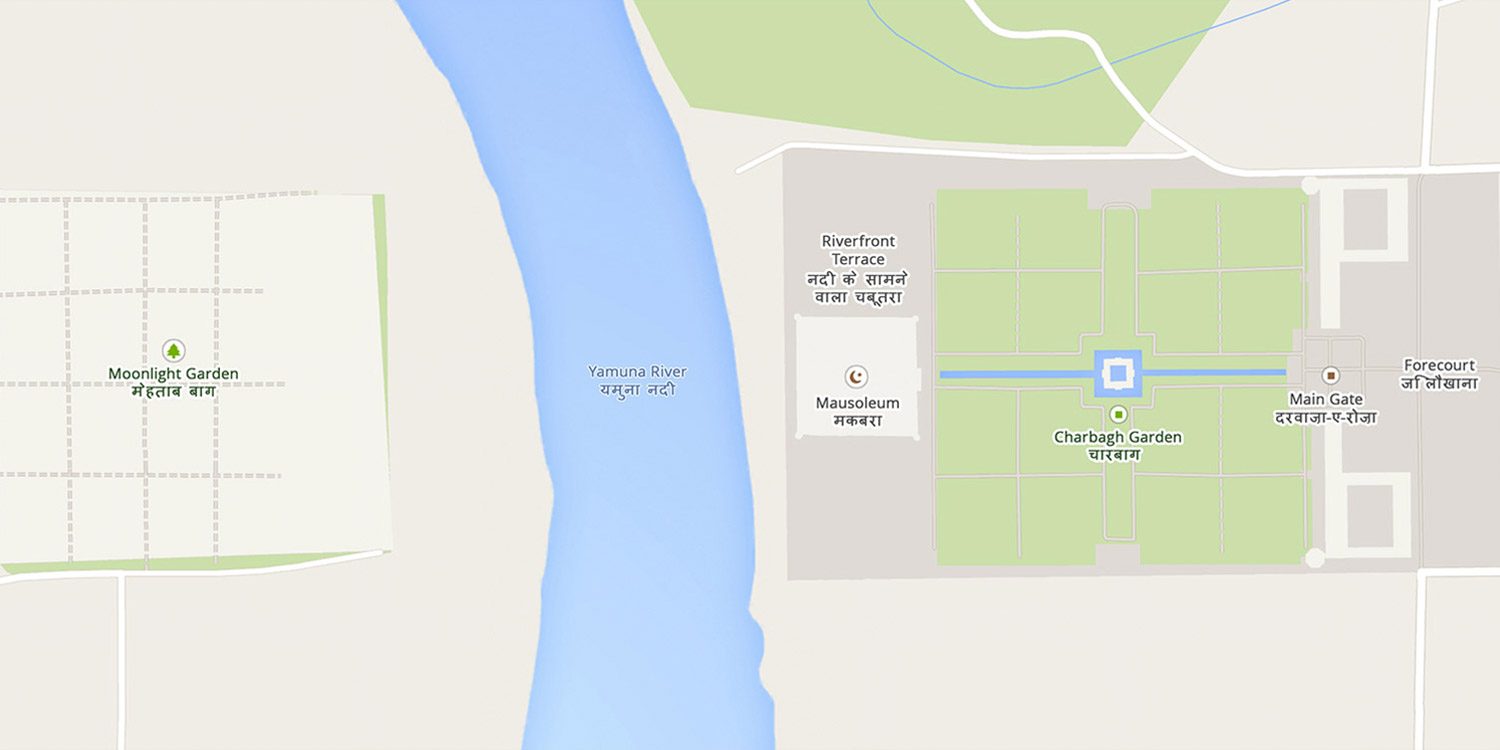
The Taj Mahal is a precisely designed complex of buildings and gardens, intricately arranged in a symmetrical plan.

The most familiar element of the Taj Mahal complex is the mausoleum, built by Shah Jahan in the 17th century for his late wife, Mumtaz Mahal. The mausoleum is recognized around the world for its domed profile, brilliant white marble construction, and architectural symmetry.

The Taj Mahal took approximately 20 years to build and more than 20,000 craftsmen and artisans worked to create what we see today. Stone inlays using yellow marble, jasper, and jade adorn the mausoleum in floral motifs, symbolizing a bountiful afterlife.
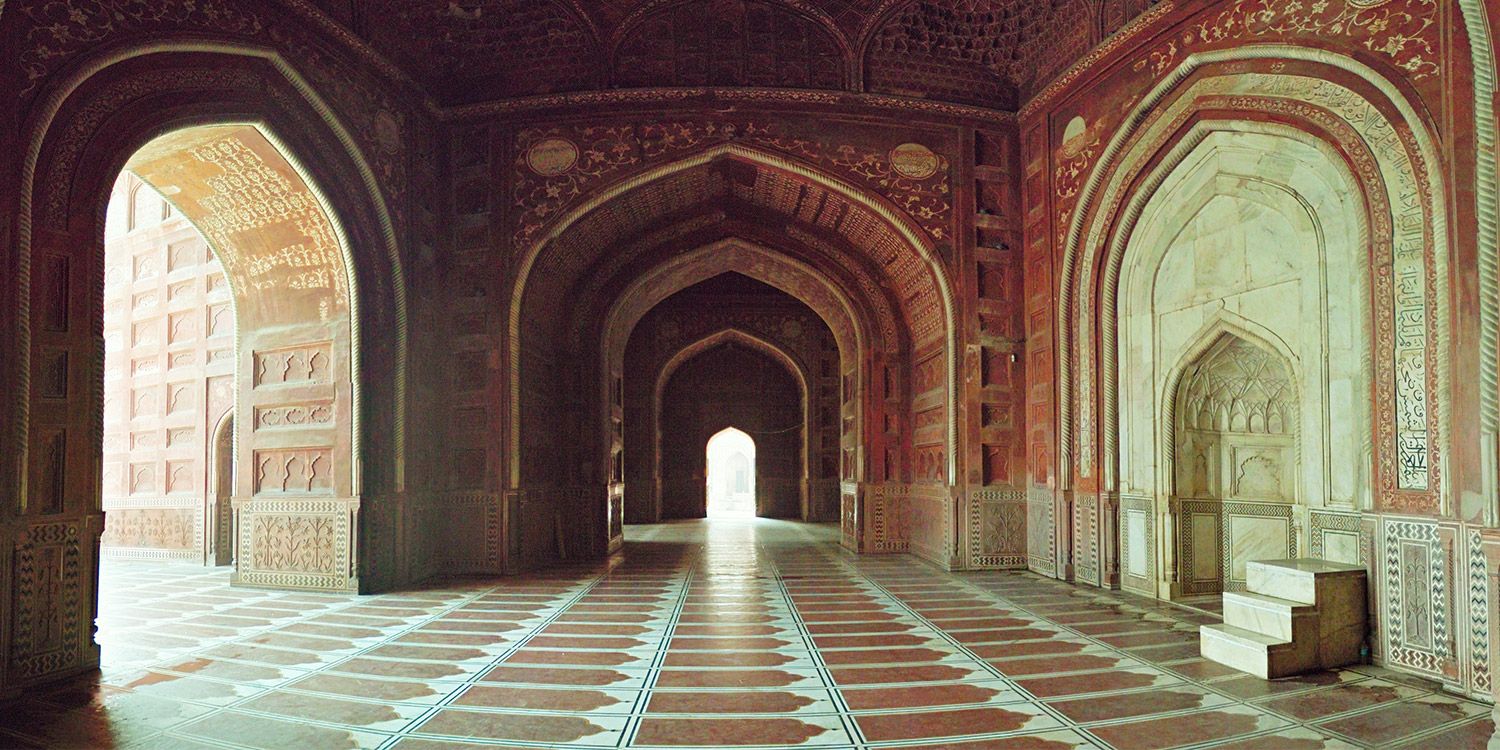
Adjacent to the mausoleum are two red sandstone buildings, flanking the east and west sides of the complex. One is a mosque. The other was built to preserve the symmetry of the site and was at one time used as a guest house.

The mausoleum is situated at the north end of an idyllic charbagh garden. Persian "paradise garden" designs were the inspiration at the Taj Mahal, combining flowerbeds, reflecting pools, and criss-crossing pathways, seen in Street View .

The symmetry of the Taj Mahal is accentuated by the water basin at the center of the garden and by the famous reflecting pool directly in front of the mausoleum. These tranquil waters reflect iconic views of the surrounding buildings and gardens.
Explore the Taj Mahal with Google Maps
Explore more views of the taj mahal.
- Skip to primary navigation
- Skip to main content
- Skip to primary sidebar
- Black Travel
- Destinations
- Travel Resources
Visit to the Taj Mahal and tips
27/03/2022 by Roobens 5 Comments
Some links are affiliate links, which means if you make a purchase through these links, I earn a commission, at no extra cost to you.
The most famous mausoleum in the world, the legendary Taj Mahal, in Agra, India! One of the best places to visit in North India ! In fact, it’s one of the places to visit once in a lifetime ! I still remember my reaction when I saw it for the first time for real, with my own eyes “ Woooooow! “. And I wasn’t even there yet, I was seeing it from afar in the city… Everybody knows at least the Taj Mahal by name, but a little bit less the history behind this monument, which is one of the new seven wonders of the world! Wanna visit the Taj Mahal? Read the article! You should definitely add this visit to your black travelers bucket list !
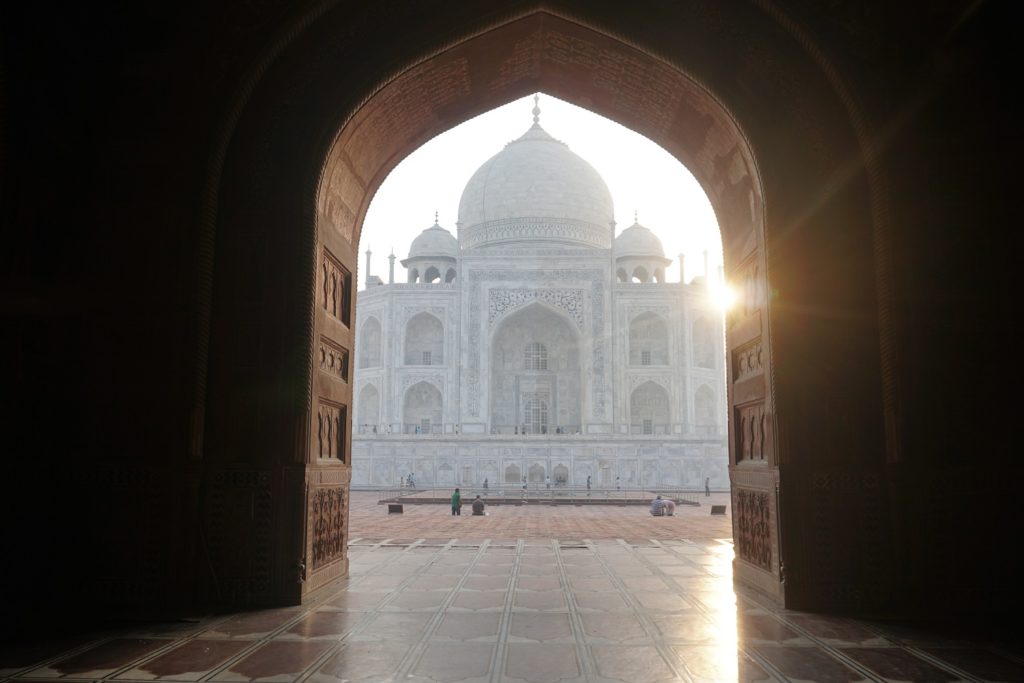
Table of Contents
History of the Taj Mahal
Why does the Taj Mahal exist? Why has it been built? The mughal emperor Shah Jahan was madly in love with his (favorite) wife, Mumtaz Mahal. He loved her so much that they had 13 kids together. However, his wife passed away after the birth of their 14th children. A few times before she passed away, she asked him to build a monument as big as their love. The emperor then decided to build the Taj Mahal, which means crown of the palace, in honor of his wife.

The snag is… The emperor was deposed by his own son before the Taj Mahal was completed, and he was put under house arrest. The poor guy saw the end of the building of his own project from his cell, at the Agra fort. When he died, his body was transfered to the mausoleum, and he’s now resting next to his wife. For your information, the emperor had a big project. He actually wanted to build two Taj Mahal, one for his wife, and one for himself! The one for his wife is the one we all know, and the second one, for himself, was supposed to be a black Taj Mahal! Imagine that! Two Taj Mahal, one white, and another one in black, with a bridge between them! Anyway, the emperor was deposed, they completed the Taj Mahal that had been under construction for years, but they never started the construction of the second one!

I arrived in Agra from New Delhi one day before visiting the Taj Mahal, and I still had a glimpse of the monument before going there. How come? There are several rooftops in Agra, and you can see the Taj Mahal from there. You have plenty of choices, they all claim to have “ the best view to see the Taj Mahal “. Being a backpacker, long-term traveling, I recommend not going to the Oberoi hotel . Drinks are more expensive than in Paris there! Either go to the rooftop of the Kamal hotel , or the one at the Saniya hotel .

How to get the best view of the Taj Mahal
The Kamal hotel is where I was staying, 5 minutes away from the Taj Mahal and they don’t market much their rooftop (or I’d rather say it’s probably not in the travel guides). Thus, very few people know it exists. I can tell, I’ve been there five or six times (it’s normal, that’s where I was staying!), and I was almost always by myself. A rooftop just for me, the service was ok, cheap place, with a view of the Taj Mahal 😀 One thing I need to clarify : you read rooftop but don’t expect anything bling bling. It’s a rustic place, and you’ll see by yourself, plastic tables and chairs are waiting for you, nothing more.

Otherwise there’s the rooftop of the Saniya hotel , 5 minutes away from the Kamal hotel. This one is more “famous”, so unless you go early in the morning, this rooftop will always be crowded (and the best seats will be taken). The place is nicer, tt’s a bit more expensive but that doesn’t mean the service is better… I vote Kamal hotel, but don’t go there if you like fancy, classy places… By the way, in both places, you need to keep an eye open! Indeed, some monkeys are prowling, and they don’t hesitate to steal people’s stuff!

Best time to visit Taj Mahal
I give all the tips at the end of the article, but as you might imagine, a wonder of the world, that popular, is constantly invaded by tourists from all over the world! To fully enjoy your visit of the Taj Mahal without feeling overwhelmed by the crowd, I strongly recommend you to be there at the opening time, 6 in the morning. That’s what I did! There will be people, but it will be nothing compared to the crowd at 8, and then all day long! Oh and if you go there early, you’ll have the unique opportunity to take pictures alone in front of this wonder of the world!
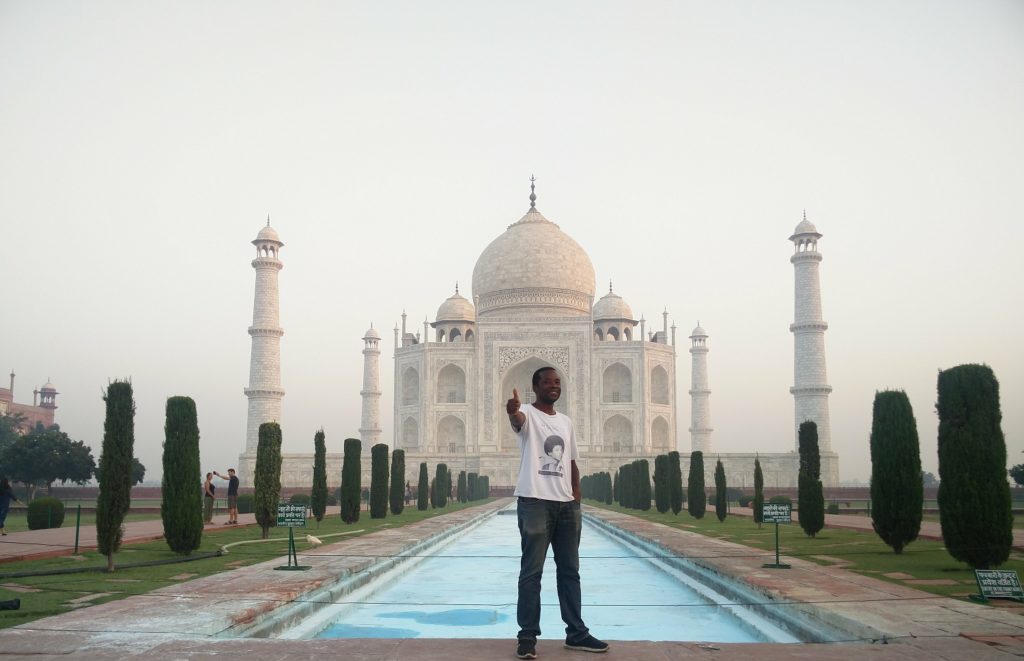
Getting in the Taj Mahal
After getting your ticket, you’ll see a small stand where you can get a bottle of a water and a small plastic bag for your shoes. This plastic bag is mandatory is you wanna get inside the Taj Mahal, otherwise they won’t let you in. And inside the Taj Mahal, where the two lovers rest, it’s forbidden to take pictures (but I saw some people who didn’t really care…).

There’s already a lot of information online about this terrific mausoleum, so I won’t write much about it! And writing about it cannot explain how beautiful this place is!!! I think I already liked and enjoyed my time there because I was inside at 6am, the opening time. When I left the Taj Mahal after 8am, it was already way too crowded for me… So I left, glad to have seen this wonder of the world!

How to get to Agra
The Taj Mahal is in Agra, about 250 kilometers (155 miles) southeast of Delhi . To go there, the easiest way is to take the train. There are six different train classes, I took the 3ac (third class with AC), I paid 815 rupees (11€) for a three-hours ride from New Delhi. You can also go to Agra from New Delhi by bus, or take a private taxi. There’s also an airport in Agra. Click here to check the latest flight prices.
Taj Mahal day trip from Delhi
A lot of tourists are doing a day trip from New Delhi to visit the Taj Mahal. They leave early in the morning from New Delhi, they arrive in Agra, they visit the Taj Mahal, and then go back to New Delhi in the evening. Why not but I don’t like to rush, and most importantly, you’ll visit the Taj Mahal at the end of the morning at best, already crowded…
The best thing to do is to go to Agra one day before (like I did!), and then leave after your visit or even the day after (like I did!). It gives you time to get in the city, not rush, visit Agra the day before or even the same day after visiting the Taj Mahal, and leave peacefully… Oh and you’ll be there at the opening time! If you still wana do a day trip from Delhi, click here for more info .
Taj Mahal tickets
How much does it cost to get in the Taj Mahal? 40 rupees (0.55€) for the indians, 1000 rupees (13.50€) for the tourists. Contrary to what I read, it’s not possible to buy your ticket one day before. If you pay, you have to go the same day! And very important, the Taj Mahal is closed on Fridays! Still, India is a cheap travel destination !
Taj Mahal entrances
Now something I would have liked to know before going there… There are three gates to get in the Taj Mahal : West gate, South gate, and East gate. The south gate opens at 8, so forget about it if you wanna get in at 6! Now west and east. For each gate, there are two lines. The first line “ Buying the ticket “, and the second one “ Getting in the Taj Mahal “.
On the West gate, you buy your ticket, walk for like 20 seconds, and then start waiting on the second line to get in. On the East gate, the first line to buy your ticket is one kilometer away from the Taj Mahal… Therefore you have to go there first, walk for 10 good minutes, and then wait on the second line to get in! So… Where should you go? East or West?
Where to get in the Taj Mahal
If you’re alone, go East! I know, you first have to buy your ticket one kilometer away, but there are way less people than on the West! So move your ass and get up early, buy your ticket, wait on the line to get in, and you’ll be among the first ones to get in the Taj Mahal. If you’re at least two people, the West gate is more convenient (you don’t need to go one kilometer away to buy your ticket, but you can go East if you want to!).
The West gate is where the buses full of tourists go and drop off the big groups, but if you’re not alone, you can work around the problem. One person buys the ticket, the other ones directly goes to the line to get in. The one who bought the tickets join the rest of the group then, and you’ll be the first ones inside.
In my case, I didn’t know all this… And I went to the West gate. I arrived at 5:20am, and went straight to the first line to buy my ticket. No one was on the second line to get in, and only two girls and 4 indians were already there! Yay! We’re all patiently waiting 5:45am, when they start to sell the tickets… Right after getting the precious paper, I rushed to get in the second line… And I saw at least 150 tourists in front of me! Whaaaaaat!? Yep, the big groups of tourists all go to the West gate , and they go straight to the second line to get in the Taj Mahal. A few indians are responsible for buying the tickets for everyone. I was sooo pissed!!!
That’s why I said earlier that if you’re alone, use the East gate. If you’re alone and you go West, you’ll have to buy your ticket anyway, and by the time you have it, dozens of tourists are already in front of you in the second line to get in. They arrived later but they don’t care, one or two indians are buying all the tickets for them. You won’t have this problem on the East gate, because all the buses arrive from the West.
What to bring to visit the Taj Mahal
Bring as little as possible with you. Ideally your phone, your money and your camera, nothing more! If you have a bag, you’ll have to go to the lockers room. You’ll waste a lot of time, because you’ll have to do so after getting in. Don’t bring any books, notebooks, papers… Otherwise after getting in, they’ll ask you to go to the lockers room which is outside… And then wait again to get in… I saw a French girl in a fury because she didn’t know and they asked her to put her bag in the lockers room, outside of the Taj Mahal…
How to take great pictures of the Taj Mahal with no one?
Once you’re inside, the best thing to do is to go straight to the back, close to the Taj Mahal. Most people stay next to the entrance to take their first pictures so if you go to the back first, you’ll have the Taj Mahal just for you. Perfect to take nice pictures with no one on it (you can see it on the main picture of this article, there’s no one!).
Where to stay in Agra
I stayed at the Kamal hotel. The only reason I picked this hotel is because of its location, 5 minutes away by foot from the Taj Mahal (didn’t want to spend one hour going there at 4 in the morning to be one of the first to get in at 6…). I’m not gonna lie, this is not the best place I’ve been to, but I contented myself with it, and the staff was really nice. Click here to book your stay .
If you prefer a mid-range hotel, there’s the Sidhartha hotel. Click here to book your stay . If you’re into luxury hotels, there’s the Oberoi Amarvilas. Click here to book your stay . All those hotels are very close to the Taj Mahal. Otherwise click here to check the hotels available in Agra.
Finally, if you prefer to stay in an apartment, click here to check the apartments available on Airbnb.
Taj Mahal tips
- Traveling soon? Check out my travel resources page! This list of travel accessories can also be useful!
- Do not go to India without a travel insurance ! It’s far from being the safest country in the world! Here’s why buy travel insurance !
- Want a tailor-made trip to India? Get a free quote here !
- I said it earlier, the Taj Mahal is in Agra, and there are a few places to visit there. I’m thinking about the Agra fort. 40 rupees (0.55€) for the indians, 550 (7.50€) for the tourists, 500 (6.50€) if you show them your Taj Mahal ticket.
- If you wanna get good food, go to Joney’s place. Small restaurant, good and cheap!
- Very important in India! For your online security, don’t forget to use a VPN! I use ExpressVPN , fast and very efficient! Here’s why use a VPN when traveling .

Sign up for exclusive updates in your e-mail address!
Related Posts

Reader Interactions
12/01/2018 at 13:40
Amazing experience. Thanks for the tips and awesome pictures.
13/01/2018 at 11:38
You’re welcome 🙂
12/01/2018 at 17:43
Great tips! Something I will have to keep in mind for the future. Visiting the Taj Mahal is a huge bucket list thing for me and I didn’t know any of these things about the ticket lines!
13/01/2018 at 11:39
I didn’t know either… Hope it’s gonna help people reading the article!
[…] of the biggest tips for visiting the Taj Mahal is to prepare yourself with ample time to […]
Leave a Reply Cancel reply
Your email address will not be published. Required fields are marked *
Don't subscribe All new comments Replies to my comments Notify me of followup comments via e-mail. You can also subscribe without commenting.
This site uses Akismet to reduce spam. Learn how your comment data is processed .

What's Inside the Taj Mahal?
The body of mumtaz mahal, the body of shah jahan, two empty cenotaphs, walls inlaid with precious stones.
- Floors Covered in Octagonal Stars
Taj Mahal is a mausoleum built in memory of Mumtaz Mahal, the second wife of emperor Shah Jahan. Mumtaz Mahal died during the birth of their fourteenth child in 1631. Shah Jahan built this ode to love in her memory unaware of what future held for him. This colossal mausoleum houses the bodies of both Mumtaz Mahal and Shah Jahan in an earthly paradise built to mirror Islamic depictions of heaven.
People often talk about the beautiful architecture of the Taj Mahal and many are left to wonder what's on the inside of this glorious monument. This article explores the internal structure of the Taj Mahal and addresses that question in detail.
Mumtaz Mahal, born as Arjumand Banu, was a Persian princess and a queen of the Mughal Empire from 1628 to 1631. Mumtaz was an intelligent young woman with a passion for learning, she mastered Arabic and Persian and even wrote poetry in the latter.
She was known for her modesty and straightforwardness which made her desirable to many, but she ended up falling in love with and marrying Shah Jahan who would one day become the Mughal Emperor. Together, the two had fourteen children.
Shah Jahan married thrice but his two of the other marriages are believed to have been merely for political alliances. It is said that Shah Jahan showed little interest in his other wives. According to the members of the royal court, the affection and love he had for Mumtaz Mahal were missing from his other marriages.
It is said that the two were inseparable and despite several pregnancies, Mumtaz accompanied Shah Jahan on his tours and even to war. She was his most trusted advisor and he consulted her in both public and private matters.
Shah Jahan attributed multiple titles to Mumtaz Mahal including Malika-i-Jahan (Queen of the World), Malika-uz-Zaman (Queen of the Age) and the one by which the world still remembers her: Mumtaz Mahal (the exalted one of the palace). During her life, her palace was adorned with gold and had rose water fountains. Upon her death, Shah Jahan built the Taj Mahal for her which until this day is a glorious piece of architecture that stands as a symbol of love.
It is said that Shah Jahan promised Mumtaz on her deathbed that he would build her the greatest mausoleum ever seen. Her body was initially buried in another site as Amanat , a temporary burial, and was moved to the site of Taj Mahal six months later and was buried in the center of a small dome over which the Taj Mahal was eventually built.
Read more on interesting facts of the Taj Mahal.
- 7-Day Golden Triangle India Tour
- 9-Day India Golden Triangle with Tiger Safari
Discover real reviews of Highlights Travel Family 's best-rated service across trusted platforms.
Shah Jahan, born as Shahab-ud-din Muhammad Khurram, was the fifth Mughal emperor (1628 to 1658) . He was regarded as the finest of all emperors and not only proved himself on the battlefield but in monuments. It was his love for building and architecture that gave him the most recognition and also created some of the most extraordinary and timeless monuments in India.
Shah Jahan is also known for his unique bond with his wife and their love has long been the subject of Indian and celebrated in both literature and cinema.
Despite being regarded as the best Mughal emperor, Shah Jahan had an unfortunate life. When he fell severely ill in September 1657, his sons started fighting over the succession of the throne. Aurangzeb, the third son won the fight but Shah Jahan recovered. In 1658 Aurangzeb overthrew Shah Jahan and ordered him to be imprisoned in Agra Fort with a view of the Taj Mahal where he spent the rest of his days until his death (January 1666).
Shah Jahan was buried next to Mumtaz Mahal in the Taj Mahal but speculators believe that he never intended to be buried there. His cenotaph is a blemish in the otherwise perfect symmetry of the Taj. While Mumtaz Mahal's cenotaph rests in the center of the tomb, Shah Jahan's lies right next to her (off-center) leading people to believe that it was not a part of the original, perfectly symmetrical design.
Cenotaphs are monuments erected to honor the dead whose bodies are buried somewhere else. Mumtaz Mahal and Shah Jahan's cenotaphs, honoring their bodies that lie underneath in the burial chamber, are decorated with inlaid precious and semi-precious gemstones . Because Muslim tradition forbids the elaborate decoration of graves , the empty cenotaphs in the main chamber are decorated with intricate patterns while the real burial site remains unadorned.
The two cenotaphs are enclosed in an eight-sided elaborate chamber decorated with pietra dura and a marble lattice screen. Down below in a quiet room at garden level lie Mumtaz and Shah Jahan in a comparatively simple marble room.
Following Islamic tradition, the two are buried with their faces turned towards Mecca (the direction in which all Muslims pray). The base and the caskets are decorated with stones and calligraphy inscriptions. Inscribed on Mumtaz's tomb are the ninety-nine names of Allah and verses from the Quran. Shah Jahan's tomb bears a calligraphic inscription that reads "He traveled from this world to the banquet hall of eternity on the night of the twenty-sixth of the month of Rajab, in the year 1076 Hijri.
Contact our India tour consultant for the essential guide to visit the Taj Mahal .
The interior decoration of the octagonal chamber of the mausoleum is particularly exquisite. It is inlaid with elaborate and intricate designs containing more than thirty types of precious and semi-precious stones. The whole chamber features floral and abstract patterns. The royal cenotaphs are enclosed by an intricately carved octagonal marble screen which is heavily ornamented with detailed patterns of fruits, flowers, and vines.
The use of such inlaid precious stones is often seen in Mughal architecture for spaces associated with the emperor or his immediate family. These ornamental decorations also serve the purpose of emphasizing the cardinal points and the center of the chamber. The exquisite walls of the chamber evoke images of the gardens of paradise full of all the riches in abundance.
The stones decorating the walls of the chamber came from around the world and include jasper from Punjab, jade from China, turquoise from Tibet, Lapi lazuli and sapphire from Sri Lanka, and real white diamonds from Panna, Rajasthan.
The Floors Covered in Octagonal Stars
The floor is paved in a geometrical pattern consisting of octagonal stars alternating with pointed cruciform shapes , formed by black marble inlaid in white marble. Around the whole floor is surrounded by a border of lobbed cartouches of alternating size. The same border surrounds the cenotaph of Mumtaz, but not the one of Shah Jahan, which was introduced later.
Large vases filled with flowers appear here instead of the individual flowering plants of the halls outside. The flowers follow botanical species more closely and one can easily identify the Mughal favorites including irises, tulips, daffodils, and narcissus.
All vases have the same general shape and all are set on little hills with small flowering plants in mirror symmetry on each side. The octagonal stars on the floor are symbolic of the eight paradises. Their presence on the floor signifies walking on the grounds of paradise, a recurrent theme in the decoration of the mausoleum.
- 9-Day Classic South India Tour
- 10-Day India Highlights and North-West Frontier Tour
Visit India with Asia Highlights
Asia Highlights welcomes the chance to help you design your perfect trip to India. Check out the following links to learn more about our tours and get a head start on planning your hassle-free vacation today!
Related Readings that you may like:
- Essential Guide to Visiting the Taj Mahal
- How to Plan a Trip to India
- Best Time to Visit India
Get Inspired with Some Popular Itineraries
At Asia Highlights, we create your kind of journey — your dates, your destinations, at your pace. You can have any trip tailor made for your travel.
More Travel Ideas and Inspiration
Sign up to our newsletter.
Be the first to receive exciting updates, exclusive promotions, and valuable travel tips from our team of experts.
Why Asia Highlights
Where can we take you today.
- Middle East
- African Safari
- Travel Agents
- Loyalty Program
- Privacy Policy
Address: Building 6, Chuangyi Business Park, 70 Qilidian Road, Guilin, Guangxi, 541004, China

Information for Tourists Visiting Taj Mahal
Water bottle is allowed inside the monument. Shoe covers, half Litre water bottle and Tourist Guide Map of Agra, Battery Bus & Golf Cart Service are provided free of cost with the SAARC, BIMSTEC & foreigner’s entry ticket for the Taj. Wheel Chair for Differently abled People & First Aid Box are available at ASI Office at Taj Mahal Ph. No : 0562 - 2330498
- Tourists must co-operate in keeping the monument neat & clean by using dustbins.
- Tourists are advised to hire approved guides & photographers who exhibit their identity cards.
- Taj Museum inside Taj Mahal Complex opens from 10.00 AM to 5.00 PM, entry free.
- No Polluting vehicles are allowed within 500 mts. radius of Taj Mahal. Parking Facility is available at Shilpgram for east gate entry & at Amrood ka Teela for west gate entry.
- From parking to Taj Mahal gate battery buses & golf carts are available.
- Drone camera is strictly prohibited inside and around the Taj Mahal.
- Eating and smoking is strictly prohibited inside Taj Mahal. Arms, ammunitions, fire, smoking items, tobacco products, liquor, eatables (Toffees), head phones, knives, wire, mobile charger, electric goods (except camera), Tripods are also prohibited.
- Mobile phones are to be kept switched off or on silent mode.
- Please avoid carrying big bags and books inside the monument, this may increase your security check time.
- Photography is prohibited inside the main mausoleum.
- Avoid touching & scratching the walls & surfaces of the monument as these are heritage sites and need special care.
- Visitors are requested not to make noise inside the mausoleum.
- Above mentioned list of prohibited items along with mobile phones are banned for night viewing of the Taj Mahal. Video camera, extra batteries are prohibited though still camera is permitted after the security check for night viewing of Taj Mahal.
Know the Agra
Discover taj, official contacts.
+91 0562 2226431 10:00 AM to 5:00PM
+91 562 2421204 06:30 AM to 09:30PM
UP Police Helpline

IMAGES
VIDEO
COMMENTS
Taj Mahal interior & Beautiful inside and outside Views - Gingerline MediaThe famous Taj Mahal in Agra, India is one of the wonders of the world. Have you ev...
Come tour with us one of the most beautiful structures on earth. The famous Taj Mahal 4k in Agra, India. We also show you rare footage of Inside the Taj Maha...
Our online virtual tour enables visitors to interactively explore the "UNESCO World Heritage Site", the Taj Mahal at Agra in India. Visitors may tour 22 different areas of the monument and gardens through 360° panoramas, maps, narrated mini-movies, music and text. A small 360° panorama below a clickable map allows a quick view of any area ...
00:00 Aerial View of Taj Mahal Tour02:07 Entrance to Taj Mahal Exterior Tour05:00 Taj Mahal Tour From InsideEmbark on a comprehensive virtual journey to the ...
Virtual Reality Tour of Taj Mahal. An immense mausoleum of white marble, built in Agra between 1631 and 1648 by order of the Mughal emperor Shah Jahan in memory of his favourite wife, the Taj Mahal is the jewel of Muslim art in India and one of the universally admired masterpieces of the world's heritage.
People in the "General Ticket" line laughing with a guard holding a huge gun. 9. Shoe coverings inside the Taj Mahal…. Upon walking into the mausoleum when you visit the inside of the Taj Mahal building, you will be given little white paper elf boots to protect the historic ground from your footsies. They look great.
Taj Mahal: A Tour from the Top. The Taj Mahal is one of the great artistic treasures of the world, an instantly-recognisable emblem of India itself. It's a mausoleum, or tomb, commissioned in 1632 by Emperor Shah Jahan, one of the greatest Mugal Emperors, to house the body of his wife Mumtaz Mahal. Here, you can take in the famous ...
9. Get there early. If I have one piece of advice for visiting the Taj Mahal, it would be to get to there early. You won't have to wait in crazy long ticket or security lines, you'll get to see the beautiful marble structure aglow in the early morning light, and there won't be crowds of people pushing past you.
Shoe covers must be worn inside the main building of the Taj Mahal. The full moon night viewing tickets cost a little less than day tickets. For foreigners, night entrance is 750 rupees ($10). Taj Mahal tickets can be purchased at the entrance gates or online. There are three entrance gates into the Taj Mahal complex: South, East, and West. The ...
Photo: Peter Adams/Getty Images. The Taj Mahal looms fairytale-like from the banks of the Yamuna River. It's India's most recognized monument and is also one of the Seven Wonders of the World. The monument dates back to 1632 and is actually a tomb that contains the body of Mumtaz Mahal—the wife of Mughal emperor Shah Jahan.
Join me on a full tour of the Taj Mahal, the world's most magnificent testimony to undying love.If you like this clip, be sure to follow me on Youtube (400,0...
Intrepid have Taj-visiting trips that range from 8-day Golden Triangle tours (now with solo-only departures!) to 15-day trips dedicated to food, to 19-day trips combining the highlights of India and Nepal. If you're more pressed for time, you can check out the Taj Mahal on a whirlwind day tour from Delhi.
Book Now: Taj Mahal Sunrise Tour from Agra. Getting to the Taj Mahal. The Taj Mahal is located in the town of Agra, Uttar Pradesh, India, which is about an hour and 40 minutes by fast train, or around 3 hours by car from Delhi. You can visit on a day trip from Delhi, or spend a day or two in Agra visiting other nearby sites such as Agra Fort.
Integrate your floor plans with Google Maps. Create and share custom maps. The Taj Mahal, India's architectural crown jewel, was built over 350 years ago by a powerful ruler in honor of his ...
How to get to Agra. The Taj Mahal is in Agra, about 250 kilometers (155 miles) southeast of Delhi. To go there, the easiest way is to take the train. There are six different train classes, I took the 3ac (third class with AC), I paid 815 rupees (11€) for a three-hours ride from New Delhi.
The #TajMahal s an ivory-white marble mausoleum on the southern bank of the river Yamuna in the Indian city of Agra. It was commissioned in 1632 by the Mugha...
Taj Mahal is a mausoleum built in memory of Mumtaz Mahal, the second wife of emperor Shah Jahan. Mumtaz Mahal died during the birth of their fourteenth child in 1631. Shah Jahan built this ode to love in her memory unaware of what future held for him. This colossal mausoleum houses the bodies of both Mumtaz Mahal and Shah Jahan in an earthly ...
Do's. Tourists must co-operate in keeping the monument neat & clean by using dustbins. Tourists are advised to hire approved guides & photographers who exhibit their identity cards. Taj Museum inside Taj Mahal Complex opens from 10.00 AM to 5.00 PM, entry free. No Polluting vehicles are allowed within 500 mts. radius of Taj Mahal.
Experience the timeless beauty and grandeur of the Taj Mahal with this immersive 360° video tour. Explore every detail of this iconic monument of love in stu...
Ticket prices. The cost of entry to the Taj Mahal increased in 2018. Foreigners must pay 1,100 rupees (around £12), with a 50-rupee discount if they pay by card. Indians only pay 50 rupees ...
Agra, India: Taj Mahal Taj Mahal, Agra, India, designated a World Heritage site in 1983. Taj Mahal, mausoleum complex in Agra, western Uttar Pradesh state, northern India. The Taj Mahal was built by the Mughal emperor Shah Jahān (reigned 1628-58) to immortalize his wife Mumtaz Mahal ("Chosen One of the Palace"), who died in childbirth in ...
Taj Mahal at Agra, India is one of the wonders of the world. The Taj Mahal (4K) was commissioned by Shah Jahan in 1631, to be built in the memory of his wife...